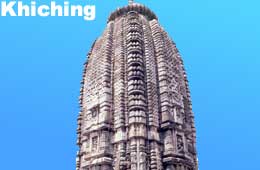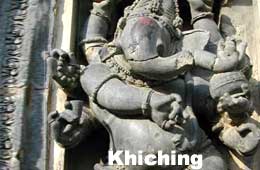| India Profile » Monuments and Temples in India » Khiching | |
Khiching | |
 | |
>
 Khiching was the ancient capital of the Bhanja rulers, located about 205 km from Balasore and 150 km from Baripada in the Mayurbhanj district of north Orissa. It was the center of art and architecture as the area has several exquisite temples and monuments. The architectural and sculptural ruins recovered from this site indicate that it must have been a major center of civilization around the 8th to 12th centuries AD. This place is the most important historical and tourist site in Mayurbhanj district. The name Khiching is a corrupted version of Khijjinga or Khijjinga-kota, the capital of the early Bhanja rulers. The ruins of the ancient glorious town can be seen from the boundaries of the present village from the bank of the Khairabandhan River in the north to the Kantakhair River in the south. Due to its geographic location and political role, it experienced varied cultural influences and liaisons. Such influences and liaisons assisted in the development of the art of Khiching. The art of Khiching expressed the aesthetic and religious sensibilities along with an individuality of its own. According to legends, Khiching had a group of eight temples dedicated to Lord Shiva once upon a time. The lingams of the seven temples can be seen even today. Today, Khiching have three ancient temples dedicated to Kutaitundi, Chandrasekhar and Kichakeswari. The ruins of the forts of Viratgarh and Kichakagarh, few stupas and several sculptures can also be seen at Khiching. The largest temple of the town is dedicated to Goddess Kichakeswari, the family goddess of the ruling chiefs of Mayurbhanj. The temple, made of chlorite, is architecturally brilliant and well carved from its outer surface. This temple is the most impressive temple in Khiching. The original temple was built somewhere in the 7th or the 8th century AD and was reconstructed in the 20th century from the ruins of an earlier temple. The shrine contains a large ten-armed skeletal image of Chamunda with striking veins, ribs and sunken belly, wearing a garland of skulls and seated over a dead body. The Parasvadevatas, the Chaitya arches, the amorous couples, the scroll works and the arabesques can still be seen in the original portions of the temple. The style of the temple is contemporary of the Brahmesvara and the Lingaraj temples of Bhubaneswar. The plinth and the walls of the temple of Chandrasekhar stand intact in the compound. The sikhara is still in position while the mastaka portion had fallen off but has been restored. The ornamentations on the lintel, the doorjambs and the dwarpalas (figures of the doorkeepers), Chanda and Prachanda, are well executed. The ruins of two fortified palaces of Khiching are worthy of visit. The largest fort is of Viratgarh on the river Khairabandhan. The Kichakagarh Fort is named after the well-known character in the Mahabharata. They were probably the royal residences of the Bhanja rulers. The excavated site of Viratgarh has unearthed the brick remains along with a number of antiquities such as pottery, terracotta figurines, stone images, beads, pieces of gold and seals. The discovery of a Kushana coin places the history of the region to the 2nd century AD. Chaula Kunji has 14 pillars out of which 4 are large and 10 are small but all monoliths. This place is to the southwest of the present Khiching temple. These pillars were brought to this location somewhere in 1932. It is also known as the Natya-Mandir and is in a dilapidated condition. The extensive ruins of Kichakagarh lie to the southwest of this site. A brick mound called Itamundia is situated to the southeast of the Kichakeswari temple complex. This place has a massive image of the Buddha. One of the doorjambs contains an image of Mahisha-Durga. Chandisal is an important place situated to the south of Itamundia. This place has been excavated and conserved. The most noteworthy discovery from this place is the carved bricks, which formed the wall of the main temple. An image of the Buddha enshrined in the lower part of the temple was found during the excavation.
There is a museum at Khiching, which is housed in the temple compound. The museum has the life-size images of Durga, Ganesha, Parsvanatha, Tara, Parvati, Ardhanageswar, Vaishnavi, Nandi, Kartikeya, Avalokiteswar, Dhyani Buddha, Mahishasuramardini, Uma-Maheswara and female devotees on display. The museum has exhibits like the copper and iron implements, terracotta figurines, seals, ornaments, potteries, coins, stone tools and various fragments of the temples. The courtyard of the museum has several sculpted parts of ancient temples on display in open. The monuments of Khiching represent one of the highest points of the Orissan sculpture tradition. It combined a highly original aesthetic sense with extraordinary craftsmanship. The temple and sculptures of the place are all found in blue fine-grained chlorite, which is more enduring in nature and conducive for receiving fine ornamentation. The iconographical evidences suggest that under the early Bhanja rulers, Khiching was a prosperous town where Brahmanism, Buddhism, and Jainism flourished side by side. |
|
 |
 Two images of Uma-Maheswara have been found from the Bhaibohu Dedhasura on the banks of the river Kantakhair. The doorjambs and the lintel of a temple in a fairly good condition were excavated from here. The laterite stone was used in the construction of the temple except the jambs, lintel and kalasa.
Two images of Uma-Maheswara have been found from the Bhaibohu Dedhasura on the banks of the river Kantakhair. The doorjambs and the lintel of a temple in a fairly good condition were excavated from here. The laterite stone was used in the construction of the temple except the jambs, lintel and kalasa.